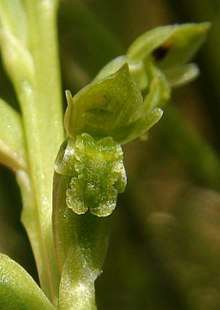Microtis oblonga
Microtis oblonga, commonly known as the sweet onion orchid,[2] is a species of orchid endemic to south-eastern Australia. It has a single hollow, onion-like leaf and up to fifty scented, bright green flowers. It is considered by some Australian authorities to be synonymous with Microtis rara.
| Sweet onion orchid | |
|---|---|
 | |
| Scientific classification | |
| Kingdom: | Plantae |
| Clade: | Tracheophytes |
| Clade: | Angiosperms |
| Clade: | Monocots |
| Order: | Asparagales |
| Family: | Orchidaceae |
| Subfamily: | Orchidoideae |
| Tribe: | Diurideae |
| Genus: | Microtis |
| Species: | M. oblonga |
| Binomial name | |
| Microtis oblonga | |
Description
Microtis oblonga is a terrestrial, perennial, deciduous, herb with an underground tuber and a single erect, smooth, tubular leaf 200–600 mm (8–20 in) long and 6–8 mm (0.2–0.3 in) wide. Between ten and fifty bright green, sweetly scented flowers are arranged along a flowering stem 400–900 mm (20–40 in) tall. The flowers are 5–6 mm (0.20–0.24 in) long and 2–3 mm (0.08–0.1 in) wide. The dorsal sepal is more or less erect, about 3 mm (0.1 in) long and wide. The lateral sepals are 3 mm (0.1 in) long, about 1 mm (0.04 in) wide with their tips rolled under. The petals are 2–2.5 mm (0.08–0.1 in) long, about 1 mm (0.04 in) wide and usually curve forwards. The labellum is oblong, 3–3.5 mm (0.12–0.14 in) long, 1.5–2 mm (0.06–0.08 in) wide with irregular edges and turns downward towards the ovary. There is a raised, dark green callus in the centre of the labellum. Flowering occurs from October to February.[2]
Taxonomy and naming
Microtis oblonga was first formally described in 1923 by Richard Sanders Rogers and the description was published in Transactions and Proceedings of the Royal Society of South Australia.[3][4] It is regarded by many Australian authorities as being a synonym of Microtis rara.[3][5][6][7] The specific epithet (oblonga) is a Latin word meaning "longer than broad".[8]
Distribution and habitat
The sweet onion orchid grows between grasses and shrubs in open forest from Gympie in Queensland south through New South Wales, Victoria and Tasmania and west to south-eastern South Australia.[2][7]
References
- "Microtis oblonga". World Checklist of Selected Plant Families (WCSP). Royal Botanic Gardens, Kew.
- Jones, David L. (2006). A complete guide to native orchids of Australia including the island territories. Frenchs Forest, N.S.W.: New Holland. p. 225. ISBN 1877069124.
- "Microtis oblonga". APNI. Retrieved 26 February 2018.
- Rogers, Richard S. (1923). "Contributions to the Orchidaceous flora of Australia". Transactions and Proceedings of the Royal Society of South Australia. 47: 339. Retrieved 26 February 2018.
- Jeanes, Jeff. "Microtis rara". Royal Botanic Gardens Victoria. Retrieved 26 February 2018.
- Bates, Robert J. (1984). "The genus Microtis R.Br. (Orchidaceae): a taxonomic revision with notes on biology" (PDF). Journal of the Adelaide Botanic Garden. 7 (1): 77. Retrieved 26 February 2018.
- "Threatened species profile Microtis rara" (PDF). Government of South Australia Department for Environment and Heritage. Retrieved 26 February 2018.
- Brown, Roland Wilbur (1956). The Composition of Scientific Words. Washington, D.C.: Smithsonian Institution Press. p. 494.
External links

